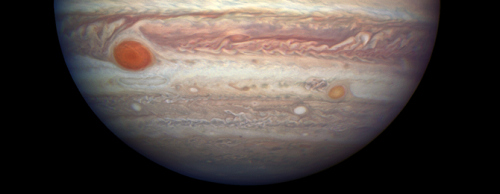Hubble Takes Close-up Portrait of Jupiter
Majestic Giant Planet is a Swirl of Colorful Clouds
Named after the Roman king of the gods, the immense planet Jupiter is undoubtedly king of the solar system. Containing more mass than all the other planets combined, Jupiter's immense gravitational field deflects wayward comets that otherwise might slam into Earth, wreaking havoc.

This dazzling Hubble Space Telescope photo of Jupiter was taken when it was comparatively close to Earth, at a distance of 415 million miles. Hubble reveals the intricate, detailed beauty of Jupiter's clouds as arranged into bands of different latitudes, known as tropical regions. These bands are produced by air flowing in different directions at various latitudes. Lighter colored areas, called zones, are high-pressure where the atmosphere rises. Darker low-pressure regions where air falls are called belts. The planet's trademark, the Great Red Spot, is a long-lived storm roughly the diameter of Earth. Much smaller storms appear as white or brown-colored ovals. Such storms can last as little as a few hours or stretch on for centuries.
Source: HubbleSite
- 305 reads
Human Rights
Ringing FOWPAL’s Peace Bell for the World:Nobel Peace Prize Laureates’ Visions and Actions

Protecting the World’s Cultural Diversity for a Sustainable Future

The Peace Bell Resonates at the 27th Eurasian Economic Summit

Declaration of World Day of the Power of Hope Endorsed by People in 158 Nations

Puppet Show I International Friendship Day 2020

